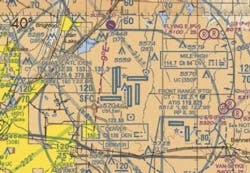Denver International Gets RNAV RNP
Boeing subsidiary Jeppesen has completed the design and delivery of area navigation with required navigation performance-based (RNAV RNP) arrivals to improve efficiencies at Denver International Airport in the US.
Designed in collaboration with the US Federal Aviation Administration (FAA) and other stakeholders, the 24-month project will improve runway performance, reduce pilot and controller workload, aircraft fuel burn, greenhouse gas emissions and cut aircraft noise.
An integral part of the FAA's NextGen modernisation programme, Europe's SESAR and other air traffic management (ATM) concepts, the PBN will assist in lessening the current delays on the ground and in the air.
With scheduled implementation from 3 December 2012, the new procedures will cut down pilot and controller workload and maximise the efficiency of aircraft operations, while making the airport more neighbour-friendly with a lower noise footprint.
Jeppesen president and CEO Mark Van Tine said: "Performance-based navigation is one of the pillars upon which NextGen and SESAR will be built, but these future air traffic management systems cannot be implemented by government alone."
RNAV and RNP specifications, through reduced onboard navigational performance monitoring and alerting, will allow more accurate lateral and horizontal aircraft routing, as well as allow aircraft to move down from altitude with no level offs in between.
The new arrival procedures are expected to offer all flight operational phases with reduced fuel burn through continuous descents, drop in miles flown, cut down pilot / controller communications, while offering increased lateral and vertical projection of operations.
Denver International Airport aviation manager Kim Day said that the new flight procedures enable the airport to meet future demand while lessening the environment impact of aviation.
"Through collaboration with Jeppesen, the FAA, airports, industry leaders and the public, Denver's skies are opened to continued growth and increased performance," Day said.
The procedures are also aimed at facilitating the air traffic system to manage and recover from weather and other problems that lead to system-wide interruptions.
Image: The implementation of RNAV and RNP arrival procedures will maximise runway throughput and assist in accelerating the flow of arriving traffic at Denver International Airport.
Copyright 2012 Progressive Media Group LimitedAll Rights Reserved

